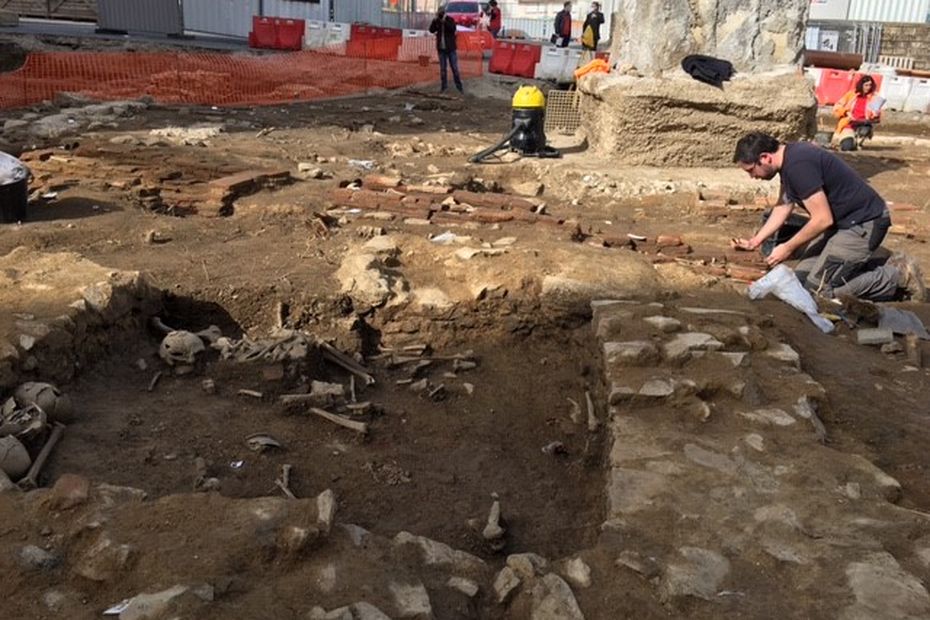The archaeological excavation site at Place Fournier in Limoges has just been completed. He unearthed more than 150 skeletons from the 13th and 14th centuries. But what will become of these human bones? Will they find a grave?
Finding human skeletons under the Place Fournier, in the center of Limoges, did not really surprise the archaeologists of INRAP, in charge of preventive excavations between February 6 and April 23, 2021. They already knew of the existence of graves, not far from there, near the remains of the Saint-Martial abbey.
The discovery of skeletons
Only four meters below the square, bones from medieval times have been discovered. More deeply, other skeletons, older, dating from the early Middle Ages, between the 5th and 7th centuries have also been brought to light. In all, 150 individuals.
On this subject, the editorial staff recommends
–
The excavation site in February 2021
•
© France Lemaire
–

Fournier Square
•
© Pascal Coussy
–
The excavation site is now finished. It now leaves room for development work undertaken by the city.

April 26, 2021 – Place Fournier after the archaeological excavations
•
© Pascal Coussy
–
The study of skeletons
The skeletons, like all the objects, the materials discovered on site will therefore join the INRAP premises to be studied there.
Archaeologists and anthropologists will determine the sex, age, size of the deceased, any pathologies or nutritional deficiencies, family ties. Everything they will learn thanks to these bones will allow them to learn more about the history of the city, its evolution, the populations who lived there …
And after ?
“The study of these skeletons is fundamental, specifies Michel Toulet, the president of the Renaissance association of Vieux Limoges, keen on the heritage of the city. But after ? What are they becoming? They are stored in sheds, “he is offended.
Michel Toulet sent a letter to this effect to the mayor of Limoges.
Is it respectful for the remains of our brothers in humanity?
Michel Toulet, president of Renaissance du Vieux Limoges
He adds, shocked: “These bones cannot be classified as pottery or stone elements.” And asks for a specific burial at the Louyat cemetery, for “these human remains found in recent, current or future excavations”.
The town hall of Limoges does not say it is opposed to this proposal, but allows itself time for reflection.
The scientists
And time is not going to be lacking. The study of the 150 skeletons, one by one, will take several years. The skeletons will thus be kept for at least five years, “individually kept”, specifies the DRAC of Nouvelle-Aquitaine. Who adds “The conservation and handling of bones are always the subject of careful care”.
Every archaeologist knows that he is dealing not with an object, but with human remains.
DRAC Nouvelle-Aquitaine
Archaeologists also allow themselves the possibility of resuming their studies on bones depending on the progress of knowledge, but also of science, such as DNA analyzes.
It is for this reason that the conservation time of human bones has no limit, as explained by Hélène Mousset, the regional deputy co-curator of archeology at the DRAC of Nouvelle Aquitaine, at the microphone of Martial Codet- Boisse and Pascal Coussy:
Hélène Mousset, DRAC New-Aquitaine
–
This notion of conservation is opposed to the article 16-1-1 of the Civil Code on the respect due to the dead, is indignant Michel Toulet, who speaks of dignity.
Michel Toulet, president of the Renaissance Association of Vieux Limoges
–
A national debate and beyond
In his essay “The Bones of Discord – the emergence of sensitivities linked to human remains in archeology“, Béline Pasquini specifies that the interest in the future of human bones discovered by archaeologists touched the Anglo-Saxon countries before France.
In the 1960s, the body of Anne de Mowbray, who died in 1481 at the age of eight, Duchess of York, was unearthed and aroused the stir of the population, before joining the abbey of Westminster.
In the 1970s, the Amerindians protested against the excavation of sites concerning human remains, the question of the ethics of archaeological research then entered the public debate. This is the case at the same time in Australia, Canada, New Zealand.
In France, the debate is later. It erupted in 2009, with the discovery of the mass grave of the battle of Le Mans.
Four years later, the remains of a noble from Brittany are discovered in a lead coffin in Rennes. Louise de Quengo was buried for the second time in 2015, in the presence of his descendants, including actor Guillaume de Tonquédec.
“In France, according to the advice issued by the national scientific commission for collections, reburials are only compulsory when requested by descendants. All requests expressed by other groups should be considered on a case-by-case basis “, says Béline Pasquini.
The compromise
Some countries, however, are beginning to find compromises between the needs of science and the ethical debate. In Australia, after being studied by archaeologists, human bones were buried in a parish cemetery.
The structure which accommodates the 70 skeletons is equipped with a water tank for their conservation. They are also accessible, in case the researchers need a new study. A solution that seems to satisfy all parties.
–


